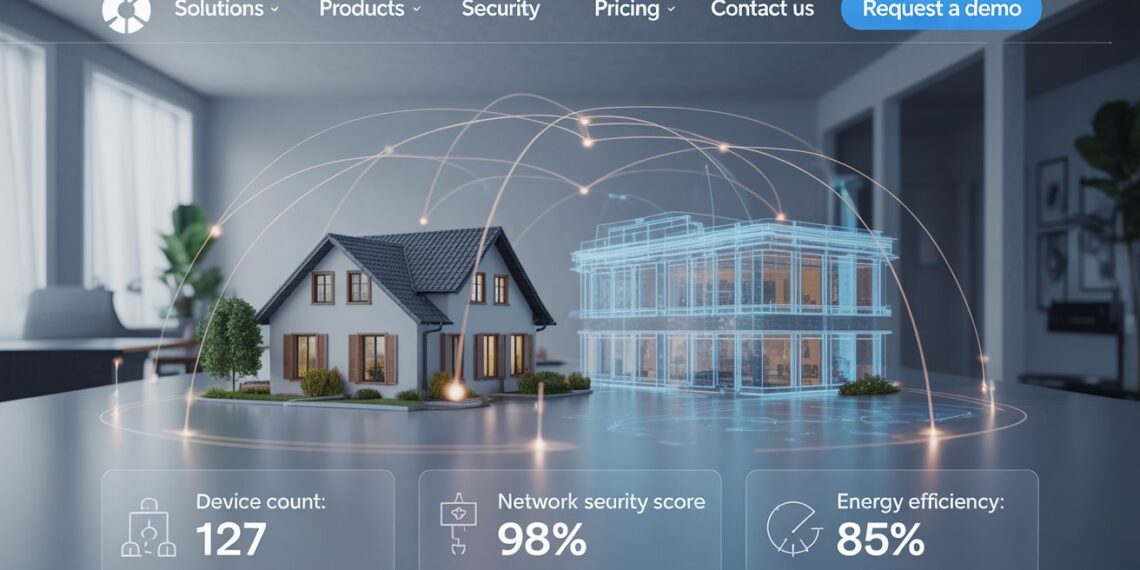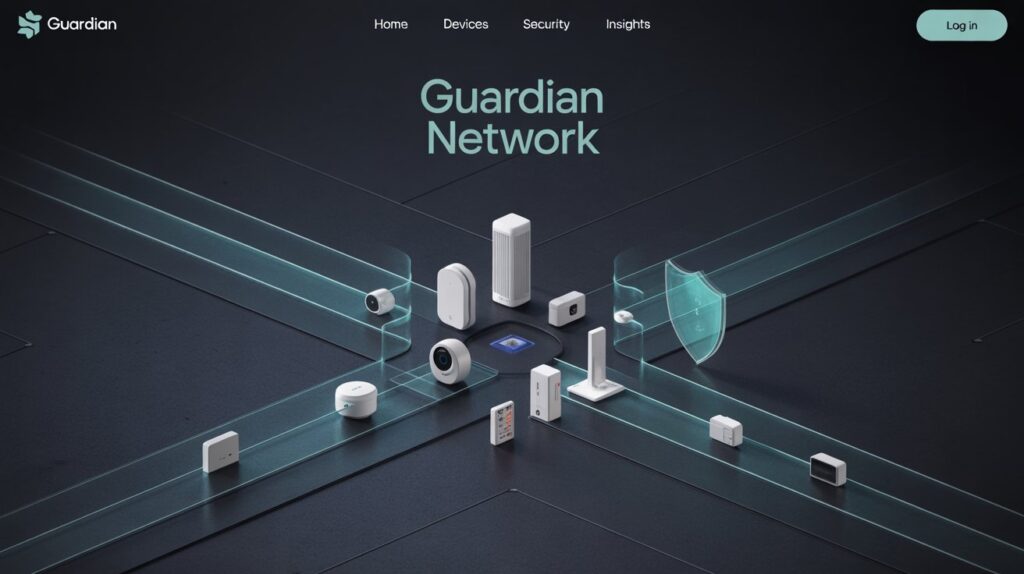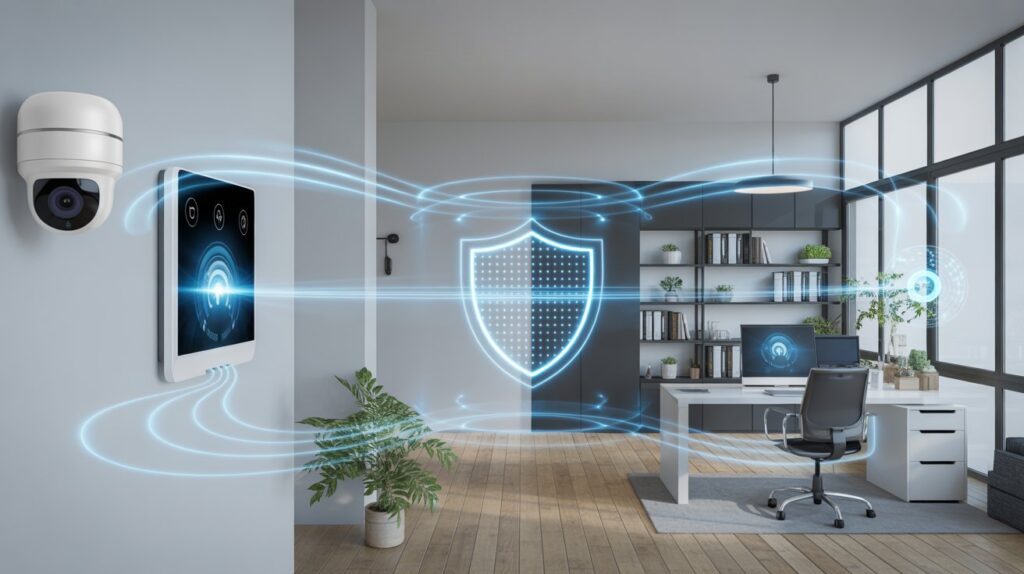From smart thermostats that adjust room temperatures automatically to intelligent lighting systems that save energy, the Internet of Things (IoT) has become a cornerstone of modern living and work environments. Smart homes and offices are now powered by connected devices that make life more convenient, efficient, and responsive.
However, this interconnected convenience comes with a cost — vulnerability. Every connected camera, sensor, or speaker is a potential entry point for cyber threats. Without proper safeguards, these devices can expose private data, disrupt daily operations, or even serve as gateways for large-scale attacks.
That’s why Securing IoT Devices for Smart Homes & Offices is no longer optional — it’s essential. This guide explores the risks, principles, and best practices to protect IoT ecosystems, whether you’re managing a handful of smart gadgets at home or hundreds of sensors in an office.
Understanding IoT Security
What Are IoT Devices?
IoT devices are physical objects equipped with sensors, software, and connectivity features that enable them to exchange data over the internet or local networks. Common examples include:
-
Smart TVs, speakers, and cameras
-
Home security systems
-
Connected lighting and HVAC controls
-
Office automation systems (access controls, conference systems)
-
Industrial sensors and energy management tools
These devices often operate with limited computing power and minimal built-in security, which makes them attractive targets for cybercriminals.
Why IoT Devices Are Vulnerable
-
Default Credentials – Many devices ship with factory usernames and passwords that users never change.
-
Weak or No Encryption – Data transmitted between devices and cloud servers may not be encrypted.
-
Outdated Firmware – Unpatched vulnerabilities allow hackers to exploit known weaknesses.
-
Poor Network Segmentation – Devices often share the same network as personal computers and business servers, creating lateral attack paths.
-
Insecure APIs or Cloud Interfaces – Compromised APIs can leak sensitive data or allow unauthorized access.
The first step in securing IoT ecosystems is understanding that every device, no matter how small, adds to the network’s attack surface.
The Growing Threat Landscape
IoT attacks have increased significantly in the past few years. Major security firms report millions of daily intrusion attempts on connected devices worldwide. High-profile incidents — such as the Mirai botnet, which turned thousands of compromised cameras into a massive DDoS network — illustrate how even simple devices can fuel devastating cyberattacks.
Threats to smart homes and offices include:
-
Botnets and Malware Infections
-
Data Theft or Privacy Breaches
-
Denial-of-Service (DoS) Attacks
-
Unauthorized Surveillance or Espionage
-
Ransomware Attacks on Smart Infrastructure
These risks highlight the need for a proactive, layered defense strategy.
Core Principles of IoT Security
Building strong IoT security relies on foundational principles that apply to both home and business environments.
1. Least Privilege Access
Grant each device and user only the permissions necessary for its intended function. This minimizes potential damage if one system is compromised.
2. Network Segmentation
Separate IoT devices from critical systems and personal computers. For example, create a dedicated Wi-Fi network for smart devices in your home or office.
3. Encryption Everywhere
Encrypt all data in transit (using HTTPS or TLS) and, where possible, at rest. Avoid devices that communicate using unencrypted protocols.
4. Regular Updates & Patch Management
Firmware updates often include security fixes. Enable automatic updates or establish a maintenance schedule to check for them manually.
5. Strong Authentication
Replace default credentials with unique, complex passwords and enable multi-factor authentication (MFA) whenever available.
6. Device Identity & Integrity
Use digital certificates or trusted device identities to verify that each connected component is legitimate and untampered.
7. Continuous Monitoring
Track unusual network behavior — sudden data spikes, unknown IP addresses, or unexpected traffic patterns could signal an attack.
Securing IoT Devices in Smart Homes
Homeowners are adopting IoT at record speed, often without realizing the risks. A few simple steps can dramatically increase your home network’s safety.
1. Change Default Settings Immediately
Upon installation, update all factory credentials, device names, and access configurations. Never use common passwords like “admin123” or “password.”
2. Use a Separate Network for IoT
Most routers allow guest networks — use one exclusively for IoT devices. Keep laptops and phones on your primary Wi-Fi to prevent attackers from moving laterally.
3. Enable Automatic Updates
Choose devices that support over-the-air (OTA) updates. If updates must be manual, check the manufacturer’s website regularly.
4. Disable Unused Features
Turn off remote access, voice control, or other unnecessary features that expand your device’s exposure.
5. Secure Smart Hubs and Gateways
Your central hub (e.g., Alexa, Google Home, or Zigbee gateway) is the brain of your smart home. Protect it with strong authentication and up-to-date software.
6. Implement Strong Wi-Fi Security
Use WPA3 encryption and disable WPS. Regularly update your router’s firmware, and avoid using the same password across multiple networks.
7. Physical Security Matters
Keep critical IoT devices — especially cameras and sensors — in secure locations. Physical tampering can override digital safeguards.
8. Monitor Devices with a Firewall
Use a home firewall or intrusion detection system (IDS) to track traffic patterns. Some routers now include AI-based anomaly detection to flag suspicious behavior automatically.
9. Vendor Reputation and Transparency
Before purchasing, review a vendor’s security track record. Choose manufacturers that release regular security patches and disclose vulnerabilities responsibly.
10. Backups and Recovery
Document your device configurations and store backups securely. In case of a breach, you can restore operations quickly without starting from scratch.
Securing IoT Devices in Smart Offices
IoT in business environments introduces higher stakes — data breaches can cause downtime, financial loss, and reputational damage.
1. Conduct an IoT Asset Inventory
List all connected devices, from printers and cameras to HVAC systems. You can’t protect what you don’t know exists.
2. Classify Devices by Risk
Group devices by sensitivity — e.g., surveillance cameras, environmental sensors, and conferencing systems. Apply stricter controls to high-risk assets.
3. Integrate IoT into Corporate Security Policy
Extend existing IT security policies to cover IoT devices. Define responsibilities for patching, monitoring, and incident response.
4. Network Segmentation and VLANs
Create dedicated VLANs for IoT devices and limit their communication to essential servers or gateways. Use firewalls to enforce traffic rules.
5. Implement Zero-Trust Architecture
In a zero-trust model, no device or user is automatically trusted. Authentication and authorization occur at every access point.
6. Secure Remote Management
If IoT devices are managed remotely, use VPNs and encrypted channels. Disable open ports and restrict access to authorized personnel only.
7. Regular Vulnerability Scanning
Run periodic scans to identify unpatched or misconfigured IoT assets. Tools like Shodan or commercial IoT scanners can help detect exposed endpoints.
8. Supply Chain Verification
Work with vendors that provide signed firmware, transparent patch schedules, and secure development practices. Avoid unverified third-party firmware.
9. Logging and Incident Response
Enable detailed logging on IoT devices where possible. Logs can be centralized using a Security Information and Event Management (SIEM) tool to detect anomalies early.
10. Employee Awareness
Train staff on IoT risks, phishing attacks, and safe device usage. Human error remains one of the biggest causes of breaches.
Advanced Defense Strategies
For environments with dozens or hundreds of IoT devices, basic precautions may not be enough. Consider these advanced techniques:
1. Intrusion Detection and Anomaly Monitoring
Deploy systems that analyze traffic patterns to detect deviations from normal behavior. Machine learning algorithms can flag suspicious data flows before they escalate.
2. Hardware-Level Security
Some devices support Trusted Platform Modules (TPM) or secure enclaves that store cryptographic keys safely. Hardware-based roots of trust are far harder to compromise.
3. Blockchain for Device Authentication
Blockchain technology can provide decentralized identity management, ensuring devices can verify each other without relying on a central server.
4. Secure Boot and Code Signing
Ensure devices boot only verified firmware. Digital signatures prevent attackers from installing malicious software.
5. AI-Assisted Threat Detection
AI-driven tools can analyze logs and network flows in real time, identifying subtle threats faster than human operators.
6. Regular Penetration Testing
Conduct ethical hacking simulations to identify potential vulnerabilities before malicious actors exploit them.
7. Redundancy and Fail-Safe Design
Design systems to fail gracefully. If one component is compromised, it should not disrupt the entire network.
Common Mistakes to Avoid
-
Ignoring Updates – Unpatched devices remain the easiest targets.
-
Using the Same Password Everywhere – Password reuse leads to cascading compromises.
-
Connecting Too Many Devices Unnecessarily – Each connection expands the attack surface.
-
Neglecting Device Disposal – Always wipe data and reset to factory settings before discarding old devices.
-
Trusting Unknown Mobile Apps – Companion apps often serve as weak links in the IoT chain.
Avoiding these pitfalls will greatly enhance your defense posture.
Real-World Case Example
A mid-sized marketing firm deployed smart conference systems across its branches. Within months, unusual outbound traffic was detected on the same network as employee computers. An investigation revealed that one smart camera had outdated firmware, allowing remote access to attackers.
The company mitigated the breach by segmenting IoT networks, enforcing regular patch cycles, and installing centralized monitoring. This real incident demonstrates how even a single vulnerable IoT device can jeopardize an entire organization.
The Future of IoT Security
The next wave of IoT innovation will include billions more devices, each demanding secure design and lifecycle management. Emerging trends include:
-
Edge Computing – Processing data closer to devices for reduced latency, but with new security implications.
-
Post-Quantum Cryptography – Preparing encryption for the era of quantum computing.
-
AI-Driven Security Orchestration – Automated systems that detect and respond to threats in real time.
-
Regulatory Frameworks – Governments are introducing IoT security labeling and compliance requirements to improve transparency.
The future will favor manufacturers and users who treat security as a fundamental design principle, not an afterthought.
FAQs
1. Why is IoT security important for smart homes and offices?
Because each IoT device is connected to the internet, a single weak point can allow unauthorized access to your data or network. Proper security protects privacy, prevents downtime, and safeguards critical systems.
2. How often should I update my IoT devices?
Check for updates at least once a month. Enable automatic updates if the feature exists.
3. What’s the best way to segment IoT networks?
Use a separate Wi-Fi SSID or VLAN dedicated to IoT devices. Limit communication between IoT and core business networks.
4. Are all IoT devices equally vulnerable?
No. Devices vary based on manufacturer practices, encryption standards, and how often firmware is updated. Always research before purchasing.
5. Can I monitor IoT security myself at home?
Yes. Tools like Firewalla, Fing, or router-based IDS systems can help you monitor connected devices and unusual activity.
Conclusion
As our homes and workplaces become smarter, the boundary between digital and physical security continues to blur. The same technology that makes daily life seamless can expose us to new types of risks.
Securing IoT Devices for Smart Homes & Offices requires more than installing antivirus software or changing passwords — it demands an integrated approach involving hardware integrity, encryption, network segmentation, and user awareness.
By implementing layered defenses, maintaining regular updates, and choosing trustworthy vendors, individuals and organizations can enjoy the benefits of IoT innovation without sacrificing safety. The key is to treat every device as a potential gateway — and guard it accordingly.












